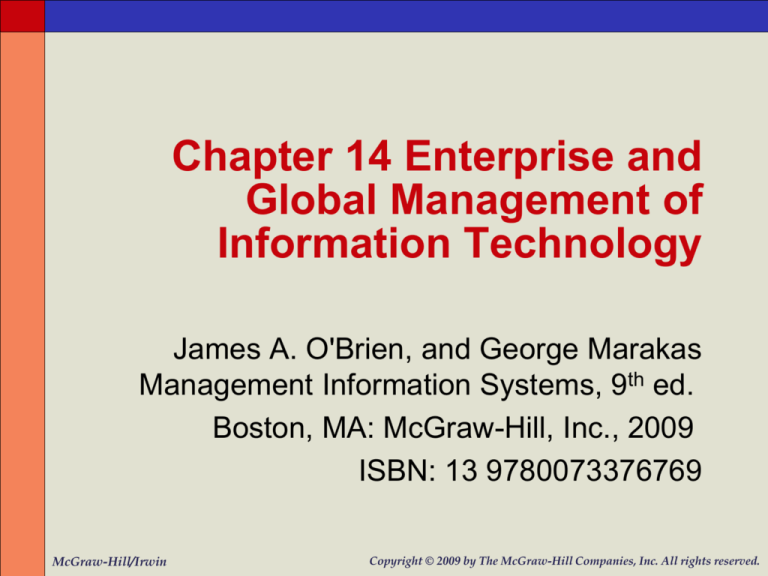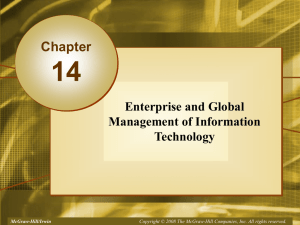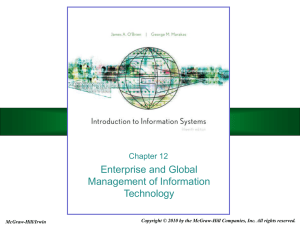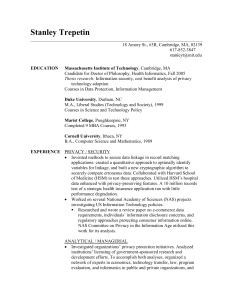
Chapter 14 Enterprise and
Global Management of
Information Technology
James A. O'Brien, and George Marakas
Management Information Systems, 9th ed.
Boston, MA: McGraw-Hill, Inc., 2009
ISBN: 13 9780073376769
McGraw-Hill/Irwin
Copyright © 2009 by The McGraw-Hill Companies, Inc. All rights reserved.
Learning Objectives
1. Identify each of the three components
of information technology management
– Use examples to illustrate how they might
be implemented in a business
2. Explain how failures in IT management can be
reduced by the involvement of business managers
in IT planning and management
3. Identify several cultural, political, and geoeconomic challenges that confront managers in the
management of global information technologies
14-2
Learning Objectives (cont’d)
4. Explain the effect on global business/IT
strategy of the trend toward a transnational
business strategy by international business
organizations
5. Identify several considerations that affect the
choice of IT applications, IT platforms, data
access policies, and systems development
methods by a global business enterprise
6. Understand the fundamental concepts of
outsourcing and offshoring, as well as the
primary reasons for selecting such an
approach to IS/IT management
14-3
SECTION II
Global IT Management Dimensions
14-5
Global IT Management Challenges
• Political challenges
– Many countries regulate or prohibit the
transfer of data across their national boundaries
– Others severely restrict, tax, or prohibit
imports of hardware and software
– Some have local content laws that specify the
portion of the value of a product that must be
added in that country if it is to be sold there
– Others require a business to spend part of the
revenue they earn in a country in that nation’s
economy
14-6
Global IT Management Challenges
• Geoeconomic challenges
– Physical distances are still a major problem
– It may take too long to fly in specialists
– It is difficult to communicate in real time
across 24 time zones
– Many countries do not have good telephone
and telecommunications services
– It may be hard to find skilled local workers
– There can be great differences in the cost of
living and labor costs between countries
14-7
Global IT Management Challenges
• Cultural challenges
– Languages
– Cultural interests
– Religions
– Customs
– Political philosophies
– Global IT managers need cultural training
before they are sent on assignment
– Different work styles and business
relationships
14-8
Transnational Strategies
• Companies are moving toward a
transnational strategy
– Business depends heavily on information
systems and Internet technologies to help
integrate global business activities
– Requires an integrated and cooperative
worldwide IT platform
14-9
Transnational Business/IT
Strategies
14-10
Global Business Drivers
• Business requirements caused by the
nature of the industry and its competitive
or environmental forces
• Examples of global drivers:
–
–
–
–
–
Customers
Products
Operations
Resources
Collaboration
14-11
Global IT Platforms
• Hardware Difficulties
– High prices
– High tariffs
– Import restrictions
– Long lead times for government approvals
– Lack of local service or spare parts
– Lack of documentation tailored to local
conditions
14-12
Global IT Platforms
• Software Difficulties
– Packages developed in Europe may be
incompatible with American or Asian
versions
– The software publisher may refuse to supply
markets that disregard software licensing
and copyright agreements
14-13
International Data Communications Issues
14-14
The Internet as a Global IT Platform
• The Internet
– An interconnected matrix that reaches tens
of millions of users in over 100 countries
– Business environment is free of traditional
boundaries and limits
• Without incurring massive cost outlays
for telecommunications, companies can
– Expand markets
– Reduce communications and distribution costs
– Improve profit margins
14-15
Key Questions for Global Websites
• Will you have to develop a new navigational logic to
accommodate cultural preferences?
• What content will you translate, and what content will you
create from scratch to address regional competitors or
products that differ from those in the U.S.?
• Should your multilingual effort be an adjunct to your main
site, or will you make it a separate site, perhaps with a
country-specific domain?
• What kinds of traditional and new media advertising will you
have to do in each country to draw traffic to your site?
• Will your site get so many hits that you’ll need to set up a
server in a local country?
• What are the legal ramifications of having your website
targeted at a particular country, such as laws on competitive
behavior, treatment of children, or privacy?
14-16
Internet Users by World Region
14-17
Global Data Access Issues
• Transborder Data Flows may be viewed
as violating
– A nation’s sovereignty because it avoids
customs duties and regulations
– Laws protecting the local IT industry
from competition
– Laws protecting local jobs
– Privacy legislation
14-18
U.S.-E.U. Data Privacy Requirements
• Key data privacy provisions
– Notice of purpose and use of data collected
– Ability to opt out of third-party distribution
of data
– Access for consumers to their information
– Adequate security, data integrity, and
enforcement provisions
14-19
Internet Access in Restrictive
Countries
• The struggle between Internet censorship and
openness at the national level revolves around
– Controlling the conduits
– Filtering the flows
– Punishing the purveyors
• Most of the world has decided that restricting
Internet access is not a viable policy
– Restricting access also hurts a country’s
opportunities for economic growth and prosperity
14-20
Global Government Internet Restrictions
• High Government Access Fees
– Kazakhstan, Kyrgyzstan
• Government Monitored Access
– China, Iran, Saudi Arabia, Azerbaijan,
Ubekistan
• Government Filtered Access
– Belarus, Cuba, Iraq, Tunisia, Sierra Leone,
Tajikistan, Turkmenistan, Vietnam
• No Public Access Allowed
– Burma, Libya, North Korea
14-21
Global Systems Development
• Key development issues
– Conflicts over local versus global system
requirements
– Trying to agree on common system features
– Disturbances caused by systems
implementation and maintenance activities
– Global standardization of data definitions
14-22
Systems Development Strategies
• Key strategies for global systems
development
– Transform an application used by the home
office or a subsidiary into a global application
– Set up a multinational development team
– Parallel development
– Centers of excellence
– Offshore development
14-23
Internet-Enabled IT Development
14-24
Case 3: General Motors: Factory IT
Faces Its Biggest Test Yet
• Today companies need manufacturing capability that can
respond quickly to changing tastes of the consumers.
• GM is looking at how it can make changes on the
production lines at its plants more deftly to react to
shifting consumer tastes.
• In 2006 and 2007, the number of vehicles on which
production ceased because of IT related problems
decreased about 50% over 2005. So far in 2008, the
number of vehicles it has had to stop production on
because of IT related issues is less than 5% of the
vehicles.
• IT plays a big part in enabling GM’s responses to market
demand.
14-25
Case Study Questions
1. What are some of the major business benefits of the type
of technology rollout implemented by GM, e.g. product
routing and order management systems? What other
benefits may accrue to the company, beyond those
directly related to improved manufacturing efficiency?
Provide several examples from both categories.
2. One of the hallmarks of GM’s rollout is the creation of four
command centers distributed throughout the world. While
local plants are the first line of defense, more important
issues are handled at these command centers. What are
some advantages and disadvantages of this structure?
Provide several examples of each and your justification
for inclusion in your list.
14-26
Case Study Questions
3. While commonality and standardization help GM
improve its efficiency and reduce costs, they may
have the downside of hindering innovation in the
different plants. Reread the statements by Kirk
Gutmann to this effect. Do you believe he means
innovation is not important? How could GM strike a
balance between these two seemingly conflicting
objectives? Provide a recommendation and rationale
for your proposed course of action.
14-27
Case 4: IBM Corporation
• Only services can provide growth on the scale that IBM
needs to make shareholders happy
– To combat cheaper offshore companies, IBM is giving
away technology
• In theory, giving away software, patents, and ideas will
– Help the entire industry grow faster
– Open new frontiers
– Create opportunities for IBM to sell high-value products and
services
• To cut costs, IBM is also offshoring
– India accounts for the largest number of IBMers outside the
United States
• By the end of next year, IBM Services head count in
India will top 52,000
– More than one-fourth of all services personnel
– About one-sixth of IBMers worldwide
14-28
Case Study Questions
1. Do you agree with IBM’s employment response to
competition from software development contractors
in India like Wipro that are expanding into IT
consulting services?
2. Will IBM’s plan to give away some of its IT assets
and intellectual property and increase support of
opensource software products be a successful
growth strategy in the “brutally competitive
marketplace” in which it operates?
3. Do you agree with IBM researchers’ assumption that
IT will remain “hard to use, expensive, and laborintensive, with customers continuing to need help
solving business problems” for along time to come?
–
Should IBM bet its business on that assumption?
14-29
THANK YOU












